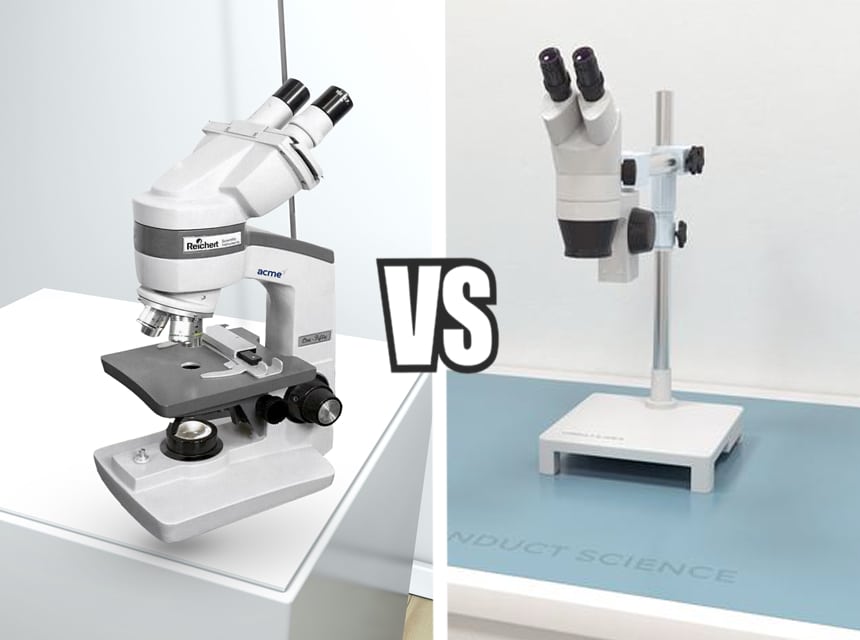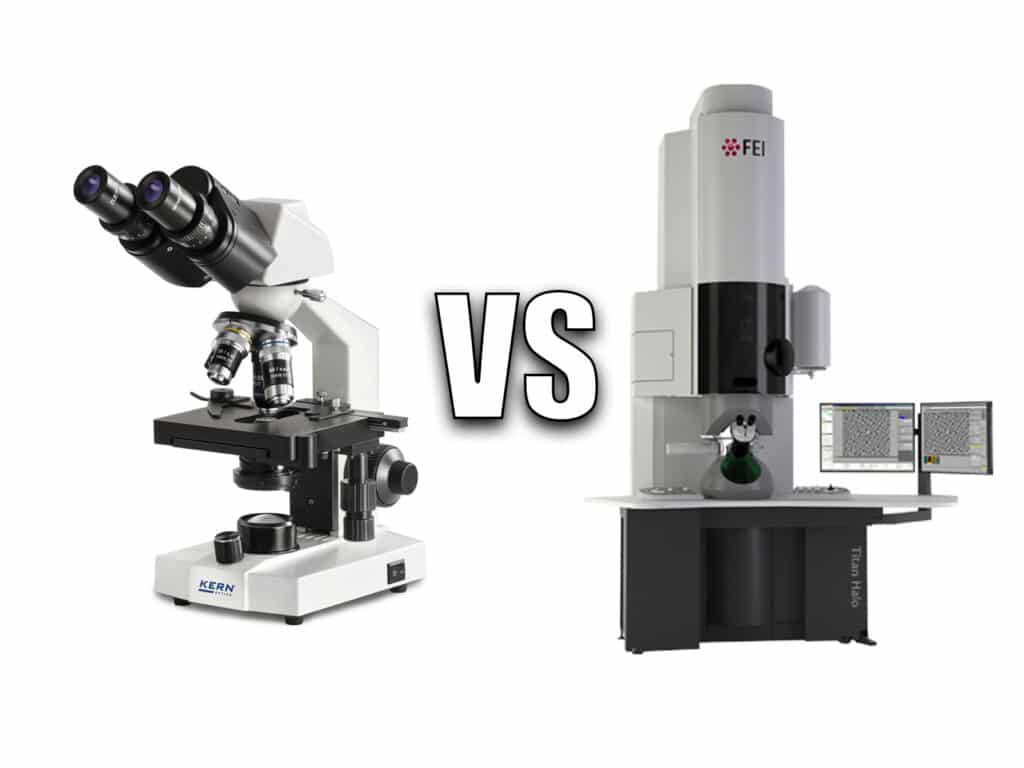

In this guide, we have explained the differences between an inverted vs upright microscope, including their individual pros and cons.
We have reviewed their main parts as well as how each microscope works. To compare the two types of microscopes, we factored in features such as lens quality, magnification, ease of use, cost and portability. We also evaluated their field of use since they are employed in different applications.
This is the type of microscope that can be bought as a smaller model for use by students in school laboratories. According to most reviews, one such model is AmScope M150C-I which features 5 magnification settings ranging from 40X to 1000X.
In an upright microscope, you peek down to view the image.
An upright microscope consists of structural and optical parts.
The structural parts are the head or body found in the upper part of the microscope, the base which supports it, and the arms used to carry the microscope and also connect the base and the eyepiece tube as well as the head to the base.
There are several optic components that are used to view, enlarge and generate an image. They include the ocular or eyepiece to view the specimen, objective lenses held by a movable nose piece to magnify the specimen, the stage where you place the specimen, knobs to adjust focus, and an aperture that allows the light source to be transmitted to the stage. Other key optical parts are the diaphragm or iris that adjusts light intensity, condenser that gathers and focuses light from the source into the sample, and a rack stop that prevents the slide from getting too close to the objective lens to and damaging them.
The staging elements and the light source are put under the specimen. An upright microscope is used to view aquatic objects, and also in cell culture to view fixed objects like cells and tissues, with the samples positioned between a coverslip and a slide. It is also used in metallurgy, the technology that is concerned with the properties, production and purification of metals.
In an inverted microscope, the condensing lens and the light source are placed above the specimen and the objective lens placed below the stage so you can look up and observe the sample through a coverslips that usually has high optical qualities.
An inverted microscope has similar components to an upright microscope, but the parts are inverted.
In this type of microscope, you look up to view the sample using ocular lens, or on a digital screen that displays real time observations. You may use a digital microscope with fluorescent illuminators and confocal scanners, and connect it to recording equipment. An inverted microscope is mostly used for live cell imaging Trusted Source A quick guide to light microscopy in cell biology Light microscopy has several features that make it ideally suited for imaging biology in living cells: the resolution is well-matched to the sizes of subcellular structures, a diverse range of available fluorescent probes makes it possible to mark proteins, organelles, and other structures for imaging, and the relatively nonperturbing nature of light means that living cells can be imaged for long periods of time to follow their dynamics. www.ncbi.nlm.nih.gov because it provides a sterile environment since there is no contact between the specimen and the objective lens that could cause contamination. Besides that, there is more space to move the sample around, and you can also easily access the sample from the top.
There are also inverted models used in metallurgy to view large samples and solid objects that are opaque.
Now we will look closely at the main factors that are important in both microscope types
To get the right type of microscope for you, you should consider where and how you will be using it. When it comes to power, performance and quick evaluations, inverted microscopes are superior to upright microscopes. They also allow you to observe large samples. This is why they are more suitable for large-scale lab projects that require more space for the specimens.
Upright models are advantageous because they are available in a wide range of options that extends their fields of use. They make ideal stereo microscopes for observing fixed objects such as insects and plant life for casual or scientific studies.
With inverted microscopes, you can place an objective lens with a high numerical aperture below the stage. Additionally, there is more room to move the objective to adjust the focal length and magnify large specimens without lowering the image resolution. Generally, upright microscopes have a longer working distance which weakens fluorescence signals and reduces resolution.
A good gemological microscope should have a magnification power of at least 40x for greater accuracy when viewing the gem’s details.
Upright models are more affordable than inverted microscopes. They are suitable for students, beginners who want to experiment and buyers on a budget. They come in an array of options to accommodate diverse budgets and applications. Owing to their generally high cost, we recommend inverted microscopes for official laboratories. However, you can still find inexpensive options such as IQCrew Science Discovery Series that is designed for kids. It has a magnification power of 40x to 200x, and includes prepared slides.
If you review the portability of an inverted vs upright microscope, you will find the latter bulkier
As we mentioned earlier, the best microscope for viewing large specimens is an inverted model. It provides more space to move the specimen because of the location of the stage, accommodates heavy specimens weighing up to 30 kg, and you can place the sample in a big petri dish. It also works fast, making it a great choice for volume laboratory work.
Upright microscopes are easier to operate, which makes them ideal for hobbyists. However, they are slow, have a greater margin for error, and they are prone to contaminating the work conditions if the objective lens comes in contact with the specimen.
There is a shorter focusing distance in an inverted microscope because you look up the eyepiece to observe the specimen.
The lenses of inverted microscopes are capable of high magnification, but they also have less working distance which makes upright models a better option for viewing through the thick plate of a conventional culture vessel.
Inverted microscopes support bigger and heavier specimens and you can view large numbers of samples Trusted Source Predicting the future direction of cell movement with convolutional neural networks Image-based deep learning systems, such as convolutional neural networks (CNNs), have recently been applied to cell classification, producing impressive results; however, application of CNNs has been confined to classification of the current cell state from the image. journals.plos.org of the same kind in a short time. It is also easier to place the sample on the stage and there is greater likelihood of maintaining a natural and sterile specimen environment. However, inverted microscopes are typically expensive although we have featured a few budget-friendly options with several positive ratings. Upright microscopes are available at different price points and for different applications. This allows users to choose the right product for their unique needs. We hope our comprehensive guide on inverted vs upright microscope has equipped you with all the information you need to make an informed decision.





